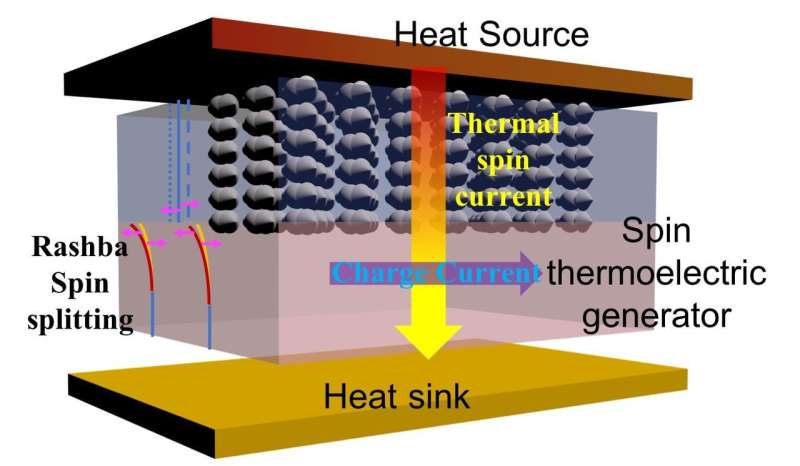Harnessing 'Rashba spin-Seebeck effect' phenomenon will enable commercial devices to turn waste heat into electricity

Mechanical engineers at the University of California, Riverside, have reported success in using inexpensive materials to produce thermoelectric devices that transform low-level waste heat into electricity.
Their advance could enable a wide variety of commercial applications. For example, integrating thermoelectric generating devices into computer chips could enable the heat they produce to provide a power source. Waste heat from automobile engines could run a car's electronics and provide cooling. Photovoltaic solar cells could be made more efficient by harnessing the heat from sunlight striking them to generate more electricity.
Also, using the same basic technology, economical thermoelectric refrigerators could be produced that would be more energy efficient and with fewer moving parts than refrigerators that use compressors and coolant. Current thermoelectric refrigerators are expensive and relatively inefficient. In essence, they operate in reverse of thermoelectric generators, with an electric current applied to generate a temperature gradient that could be used in cooling.
While thermoelectric generators have been highly dependable—for example powering space probes such as the Voyager spacecraft for decades—their use has been limited by the expense and complexity of the materials they required.
However, researchers led by Assistant Professor of Mechanical Engineering Sandeep Kumar, have reported achieving significant thermoelectric energy conversion using a combination of a nickel-iron alloy and silicon. The scientific paper on their results recently appeared online in the journal Physica Status Solidi- Rapid Research Letters. Co-authors of the paper were graduate students Ravindra Bhardwaj and Paul Lou.
In their experiments, the researchers constructed a super-thin two-layer sandwich of nickel-iron Permalloy and a form of silicon called p-type silicon. The Permalloy layer was 25 nanometers thick, and the researchers produced devices in which the silicon layer had thicknesses of 100 nanometers, 25 nanometers and 5 nanometers. By comparison, a human hair is about 200 microns thick.
When the researchers applied heat to the Permalloy layer, they were able to produce an electrical voltage in the sandwich, due to a recently discovered physical phenomenon known as the spin-Seebeck effect. In this effect, a temperature gradient generates a spin current from the ferromagnetic substance, producing an electrical voltage in the silicon. The enhanced voltage produced in the device was due to a mechanism called the "Rashba spin-orbit coupling."
The researchers achieved one of the largest such voltages yet measured in the device with the 5 nanometer-thick silicon layer.
"Such devices will be able to generate electricity in any situation in which there are small gradients in temperature," said Kumar. "For, example, a computer chip typically heats up to about sixty degrees Centigrade, while the surrounding temperature may be twenty-five degrees. So, such spin-thermoelectric generators integrated into computer chips could generate significant amounts of electricity from heat that would otherwise be wasted."
"Also, photovoltaic solar panels become quite warm, so integrating thermoelectric generators into such panels could generate additional electricity from that waste heat," he said. "Thermoelectric generators could also be integrated into automobiles, where engine temperatures can reach a hundred degrees centigrade, compared to an ambient temperature of twenty-five degrees. In such an application the generated electricity could power the car's electronics and even provide cooling."
The latest experiments constitute only the beginning of development of the new thermoelectric technology, said Kumar, who added that a provisional patent for the discovery has been submitted.
"We have only just scratched the surface of the possibilities," he said. "We believe we can generate even more energy from the same temperature gradient by using multiple layers, just as putting batteries together increases energy output. And, we are exploring other earth-abundant, inexpensive materials that could prove effective in spin-thermoelectric devices."
The title of the paper is "Giant enhancement in Rashba spin-Seebeck effect in NiFe/p-Si thin films."
More information: Ravindra G. Bhardwaj et al. Giant Enhancement in Rashba Spin-Seebeck Effect in NiFe/p-Si Thin Films, physica status solidi (RRL) - Rapid Research Letters (2018). DOI: 10.1002/pssr.201800064
Provided by University of California - Riverside



















